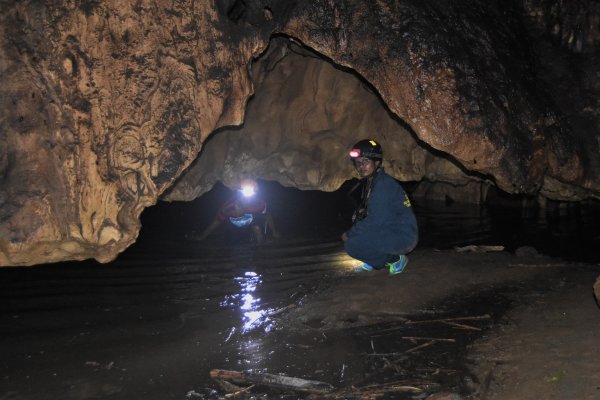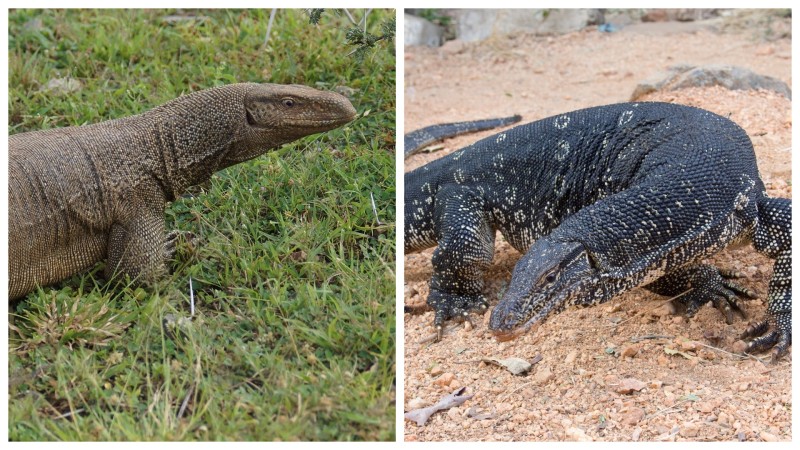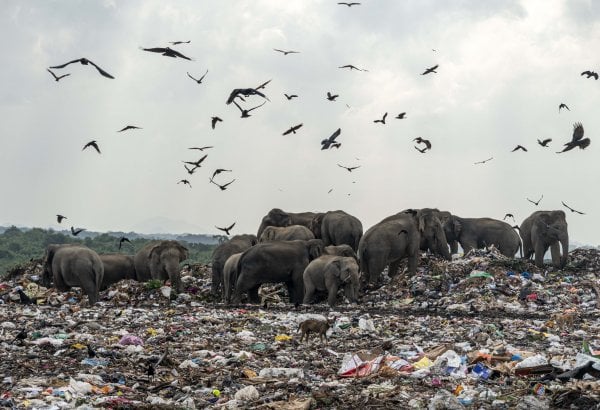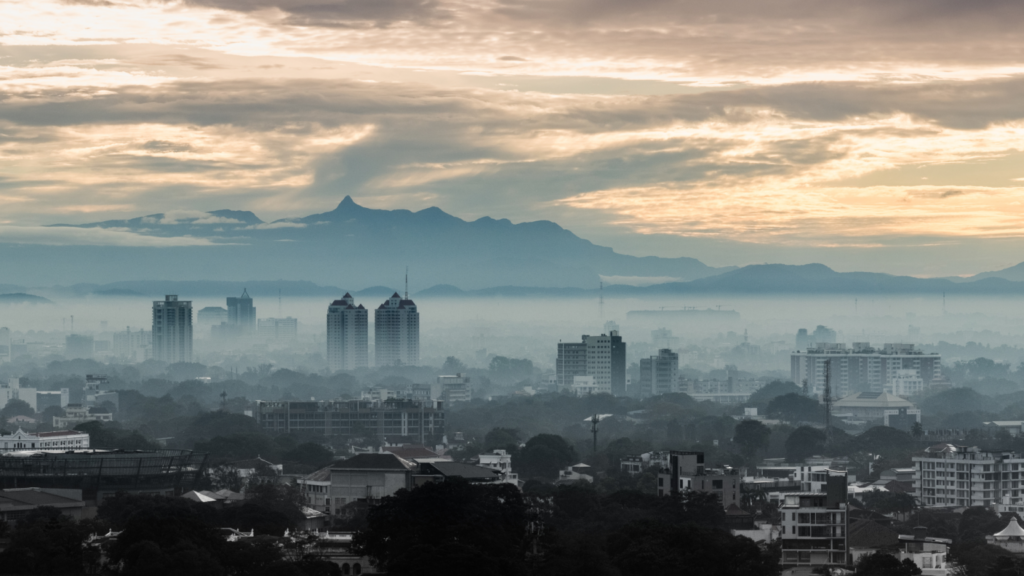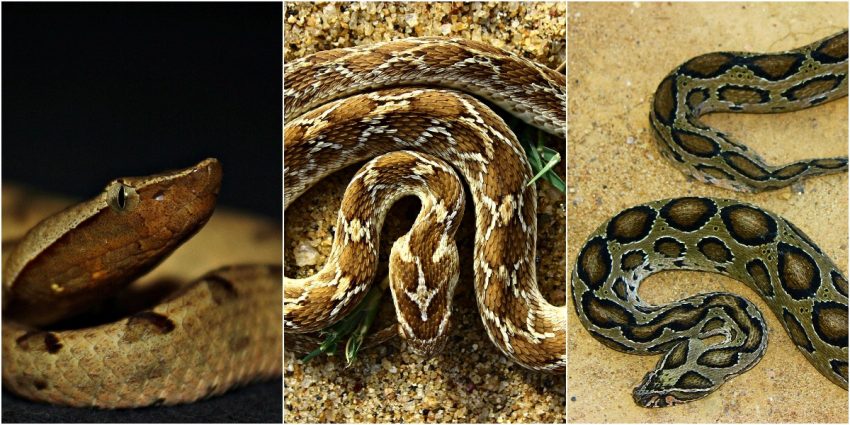
Sri Lanka is home to a number of interesting species of snakes, and while this may bode well for reptile lovers and wildlife enthusiasts, there are others who – quite understandably – aren’t overly excited about it.
We suspect this may have something to do with the fact that some of these snakes are highly venomous, which means they have the potential to kill you, should you get bitten by one of them.
At the same time, widespread fear among Sri Lankans has also meant bad news for the snakes – because snake encounters, more often than not, result firstly in panic, and secondly in an attempt to get rid of the snake by any means possible, even if it means killing the creature (and sadly, this happens a lot).
In case you were thinking that this article sounds like it’s just about to tell you NOT to kill snakes no matter how scary they may seem, then you’re right, that’s precisely what we we’re about to say.
And why not kill them? As reptile expert Dinal Samarasinghe points out, killing a snake is a course of action that must be taken only as a last resort, because ‒ although this may be hard to believe sometimes ‒ the animal is always, always, more afraid of you than you are of it.
To add to this, with the exception of five species of venomous snakes on land, all other snakes in Sri Lanka are in fact legally protected under Section 31 of the Flora and Fauna Protection Ordinance (FFPO). This essentially makes it illegal to kill snakes, or even transport, dead or alive, a snake or any part of the snake, or even its eggs.
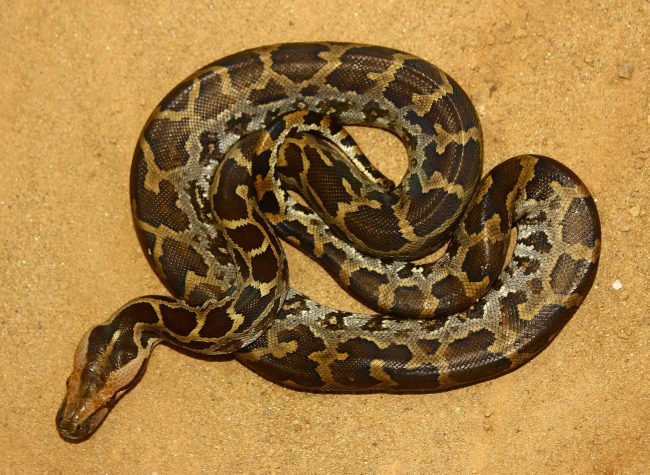
The Indian Rock Python, although it looks intimidating, is non-venomous. It is spread throughout the island, except in cold regions.
In spite of this, people do have a tendency to kill snakes for reasons ranging from inconvenience, to genuine fear.
According to Samarasinghe, this could happen for a number of reasons, mostly: a lack of proper awareness, general misconceptions, or an inability to accurately identify them as dangerous or not.
Venomous snakes are divided into three categories: highly venomous, moderately venomous, and mildly venomous. We’ll be focusing on the first category.
Here’s a list of the five highly venomous species of snakes on land:
Russell’s Viper (locally known as tith polonga)
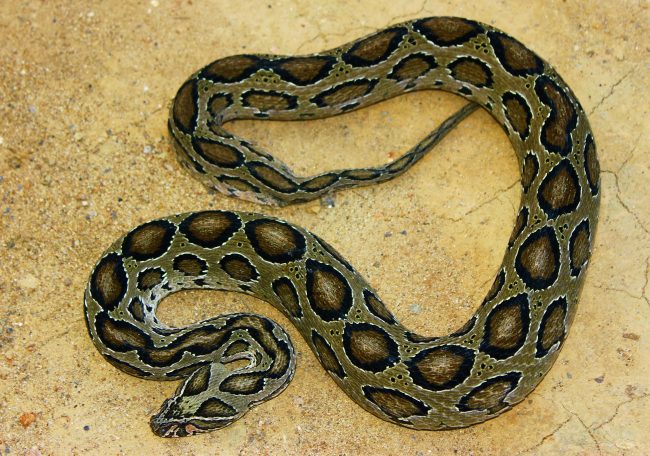
Russell’s Viper (Daboia russellii) – not to be confused with pythons
This one you’ve probably already heard of, and been warned against, which is a good thing, as they can in fact be quite dangerous (although the words ‘highly venomous’ gave that away already, huh?). The problem is, the Russell’s Viper has a tendency to be confused with pythons, which are NOT venomous. So how do you tell the two apart?
The shape of the snake’s head is key in identifying the two snakes: the Russell’s Viper has a an arrow shaped, pointed head, while the python, too, has a triangular shaped head, but a blunt snout.
Additionally, you could also take a look at the patterns on their bodies: the Russell’s Viper has a distinct pattern along its vertebra, consisting of brown, oval shapes all over. The python, on the other hand, has larger, cloud-shaped blotches on its body. There are two kinds of pythons found in Sri Lanka: the Indian Rock Python, and the Sand Boa.
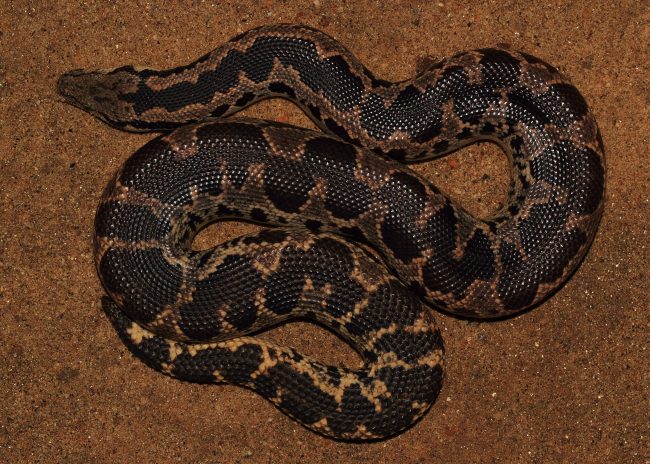
The Sand Boa, found mainly in the arid, semi-arid, and dry zones
[Quick fact: while most of us think ‘DANGER’ when we hear the word ‘python’, these guys, although possessing the potential to be quite aggressive, are NOT venomous. At most, they could wrap themselves around your neck and cause asphyxiation, so just don’t try to wear them as scarves and/or bully them.]
Cobra
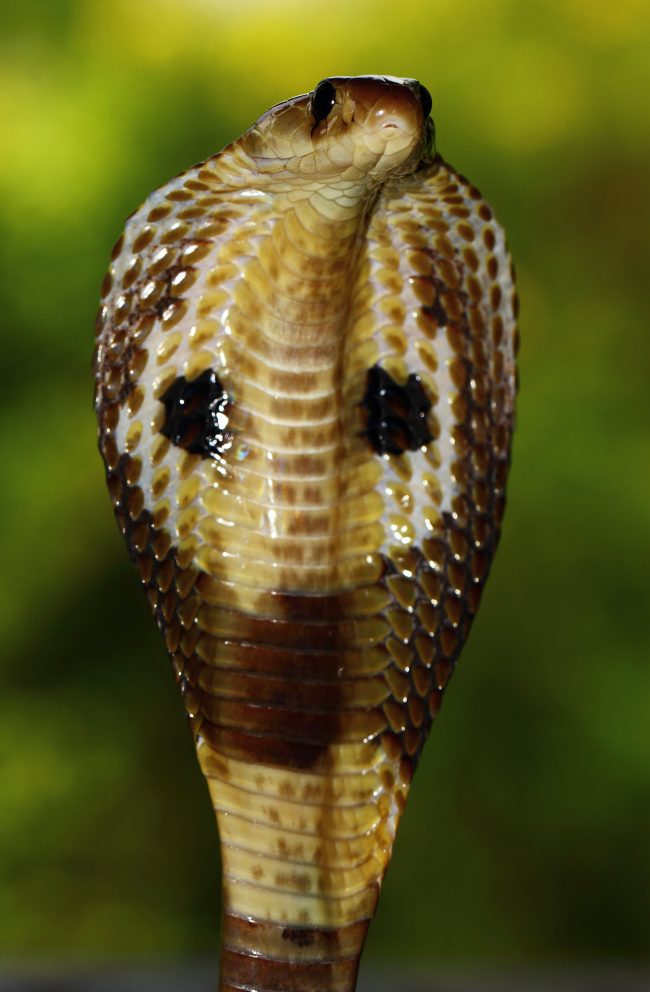
Spectacle cobra (Naja naja)
This is perhaps one of the easiest snakes to identify, thanks to its head, which takes on a flattened, hooded shape. Cobras are found right throughout the island, even in Colombo.
If you don’t want any visits from one of these venomous reptiles, just make sure your houses and storerooms are rodent-free. Their movement is determined by both food and habitat, and they are known to use rodent burrows to move around, and also to lay eggs. They usually choose, depending on weather conditions, a particular time to exit their burrows and bask outside.
Kraits
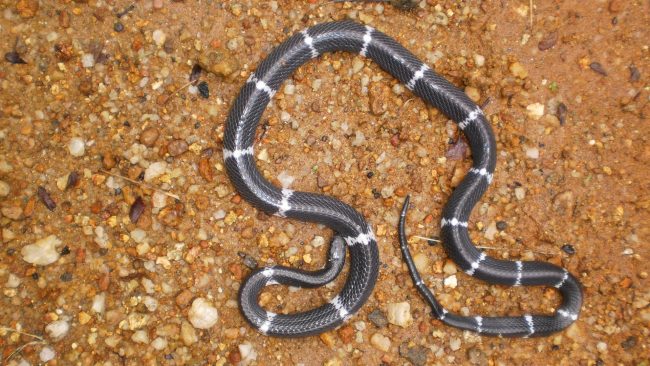
The Sri Lankan Krait (or Ceylon Krait)
Sri Lanka is home to two species of Krait classified as highly venomous: the Common Krait, and the Sri Lankan Krait (or Ceylon Krait).
Possessing a highly potent venom, the Common Krait is the most dangerous land snake in Sri Lanka: it would take just around 0.6 mg of its venom to kill a person. What’s more, they have tiny fangs, so you may not even feel the bite; at most, it could feel like an insect bite. Once bitten, a person would even display minimal local effects, except perhaps for a little swelling.
The venom has a direct impact on the nervous system, which in turn would paralyse the muscles that facilitate breathing.
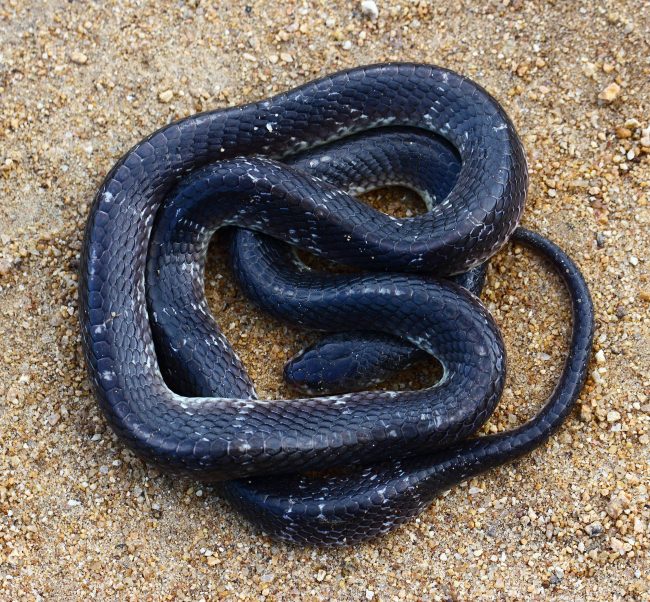
The Common Krait, the most dangerous of them all.
As freaky as this sounds, there is little reason to panic if you understand the distribution of these snakes.
Neither one of these kraits is likely to be found near Colombo. The common krait is likely to be found in the dry and arid zones, while the Sri Lankan krait can be found in the wet zone, particularly where there is good forest cover, and closer to rural village areas. It is also common around Pidurutalagala.
Saw-scaled Viper
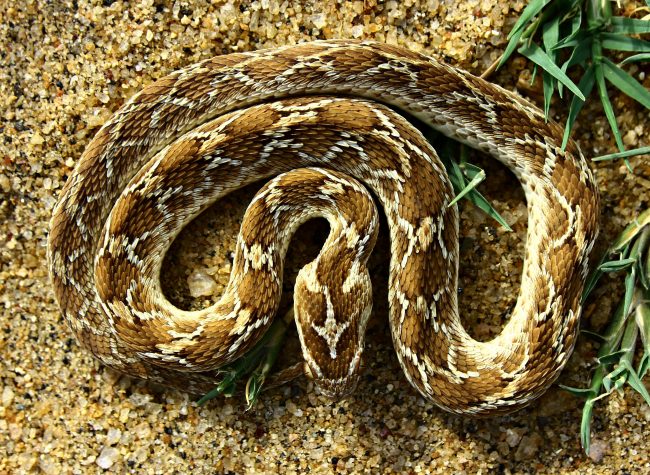
The saw-scaled viper
This viper can be found mostly in coastal areas, and also in the arid zone. They are identifiable by the pattern on their heads, which resembles a bird’s footprint. The sides of their bodies display a lateral zig-zag pattern.
Hump-nosed Pitviper
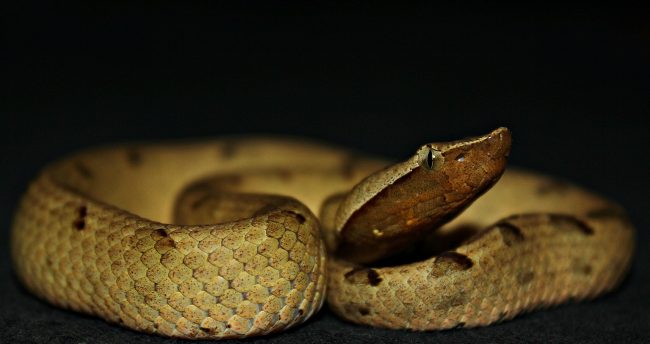
Hump-nosed pitviper (Hyplnale hypnale)
Although not on the original list of five highly venomous snakes on land, the hump-nosed pitviper (Hypnale hypnale) is now considered highly venomous by the Medical Council, explains Samarasinghe. He added that this species is responsible for the highest number of snake bites in Sri Lanka every year ‒ and for this reason is also considered a “medically important venomous snake” in our country.
This snake is endemic to India and Sri Lanka, and has a small, pointy, arrow-shaped head, with an elongated nose. It is often found coiled up, its head at a 45 degree angle from the ground. These vipers can grow up to about 1 ‒ 1.5 feet, have very long fangs, and possess a mean temper ‒ which means they won’t hesitate to bite. They are commonly distributed in forest/rain forest areas, as well as in suburbs (in the West, around Homagama, Kottawa and beyond) and usually found amidst leaf litter.
What Should I Do If I Encounter A Snake?
As explained earlier, the main idea is not to panic, and to avoid killing the snake unless absolutely necessary. If you don’t encounter it in a domestic compound, the best thing to do is leave it alone, and avoid any interactions with it.
If it has strayed closer to home, one option would be to catch the snake. You could do this by using a one-sided pipe (any good ol’ S-Lon tube would do, just attach a cap at one end and leave one end open). Leave the pipe close to the snake and, using a broom or a wiper-mop, coax the creature into the tube. Once it’s inside, cap the other side too. As an alternative, you could use a plastic water bottle for smaller snakes, or a jute sack for larger ones – just make sure you use something to tie it up tightly.
After this, you could either release it into the wild, or better yet, get in touch with the Department of Wildlife for instructions on what to do.
In The Event Of A Snake Bite…
The first thing to do, Samarasinghe says, is to wash the wound immediately with running water, and rush the patient to the nearest Government hospital, within 45 minutes to 1 hour. It is important to keep the victim calm; also, a clear identification of the snake, whenever possible, will help doctors in administering an anti-venom.
The important thing to remember is that snakes will leave you alone unless provoked, so whenever possible, leave them alone. They are also a vital part of the ecosystem, being both predator and prey, so killing them should only be as a last resort. Essentially, snakes are best left alone to their own devices. They can be rather fascinating creatures, but if you come across one in the wild that you suspect to be dangerous, for both your sake and the snake’s, just let it be.
[One last thing: if you’re not too wary of snakes after what you just read, and would, on the contrary, like to see some up close, there’s a fascinating snake conservatory you could check out down South]
All images courtesy Dinal Samarasinghe.

